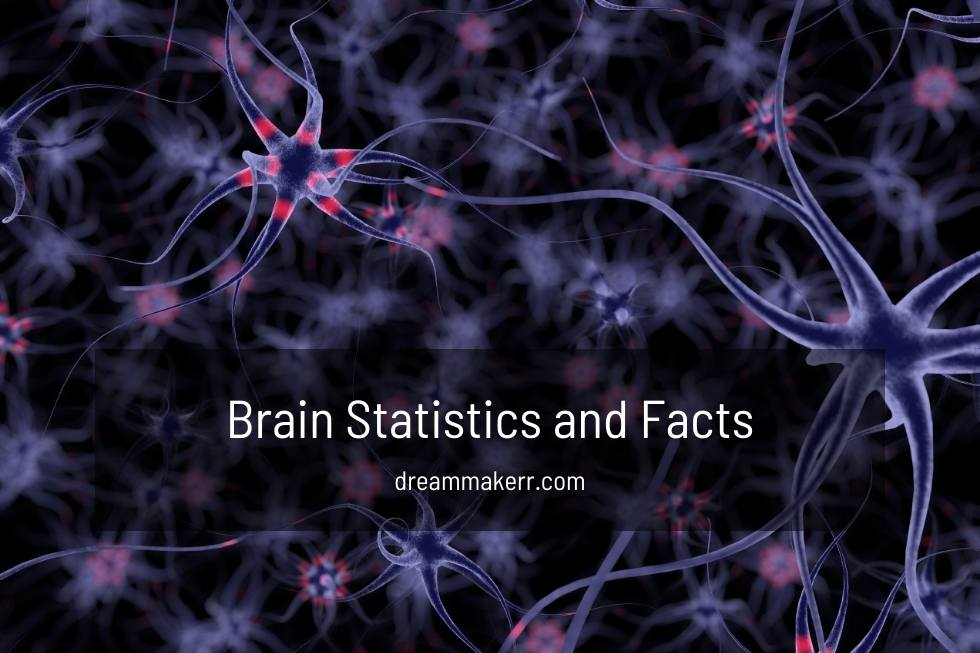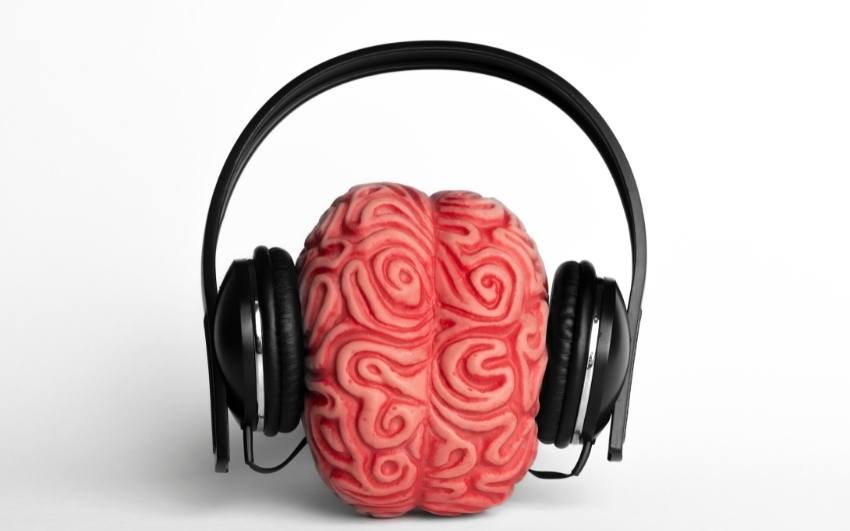On this page

77 Brain Statistics To Help Us Understand How We Function
Many brain myths are debunked by these scientific brain statistics and facts. Learn how the brain works for the better (or worse). All information is derived from primary sources.
There are many false brain “facts” floating around. It makes sense; studying the human brain is one of science’s least explored areas. Even experts agree that we have a lot more to learn about the brain than we do now. In recent years, our understanding of the brain has grown exponentially, and there are fewer false brain “facts” floating around.
The majority of what modern medicine knows about the brain has been discovered in the last 15 years; as a result, many brain facts have yet to gain widespread attention.
Brain Statistics You Should Know About

The human brain is a complex and unique organ that controls everything from sensory information processing to motor skills.
- The brain weighs about 2% of the body’s total weight but consumes 20% of its total energy and oxygen.
- The human brain is 73% water on average. Only 2% dehydration can affect your attention, memory, and other cognitive abilities.
- The brain contains many billions of neurons that are linked together by synapses. Electrical impulses are sent down the axons of these neurons to communicate with one another. The electrical signals are then transmitted to the dendrites of other neurons via synapses.
- The human brain consumes a significant amount of energy, accounting for approximately 20% of the body’s total energy intake. This high level of energy consumption is required to keep the Brain at a high level of activity.
- An oxygen deficiency in the brain can be fatal. Even a few minutes without air can cause significant damage to some brain cells.
General Human Brain Statistics and Facts

Our brains contain the most sophisticated example of intelligence we know.
Here are some fascinating numbers about the human brain.
- The brain weighs about 2% of the body’s total weight but consumes 20% of its total energy and oxygen.
- Your brain is approximately 73% water. Only 2% dehydration can affect your attention, memory, and other cognitive abilities.
- Sweating for 90 minutes has the same effect on the brain as one year of aging.
- The human brain weighs approximately three pounds.
- The brain contains 60% of the body’s fat. The brain is then the fattiest organ in the body, accounting for 60% of its weight.
- The brain contains 25% of the total cholesterol in the body. Every brain cell requires cholesterol. If there is insufficient cholesterol, brain cells die.
- Although an exact count is impossible to obtain, the brain most likely has around 86 billion neurons.
- Every neuron can send 1,000 nerve impulses per second and form tens of thousands of synaptic connections with other neurons.
- A single grain of sand could contain enough brain tissue to weigh one pound. It contains 100,000 neurons and 1 billion synapses that are constantly communicating with one another.
- Brain cells are not all alike. The brain has 10,000 different types of neurons.
- An oxygen deficiency in the brain can be fatal. A few minutes without air to the brain can cause significant damage to the brain cells.
- Babies have massive craniums to accommodate their rapidly developing brains. A 2-year-brain old’s is roughly 80% the size of an adult’s.
- Adolescence is a time of rapid brain development, but it is not without risks. The human brain reaches full maturity until around the age of 25.
- The electrical activity in your brain can reach speeds of up to 268 miles per hour. This is faster than Formula 1 race cars, which can reach 240 mph.
- The brain uses approximately 20 watts of power. This is enough to power a low-wattage light bulb.
- The brain has been dubbed a “random thought generator” for a reason: the average human brain produces 48.6 ideas per minute, according to the Laboratory of Neuro Imaging at the University of Southern California. This equates to 70,000 thoughts per day.
- Every minute, the brain consumes roughly one-third of the total blood volume of the human body. This amount is sufficient to fill a bottle of wine or a liter bottle of soda.
- Your brain’s ability to process an image compared to your eyes, are seen in less than 13 milliseconds — slower than the blink of an eye — the eye area processes visual information at a rate of 120 images per second.
Interesting Brain Size Facts

If you have been curious about brain size facts and figures you may be surprised by some of the following information:
- Men’s brains are 10% larger than women’s. Females have a larger hippocampus, the part of the brain most closely associated with memory.
- Albert Einstein’s brain weighed 2.71 pounds (1,230 grams), or 10% less than the average weight of 3 pounds (1,360 grams). His neuron density, on the other hand, was significantly higher than average.
- The brains of Neanderthals were 10% larger than those of modern humans.
- Humans have the largest brains about their body weight of any species, but we don’t have giant brains. Sperm whales have the largest brain in the world, weighing 17 pounds.
- Human brains have become smaller over the past 20,000 years. The volume lost is comparable to that of a tennis ball.
- Cab drivers in London have a larger hippocampus, or “memory center.” This is due to the mental exercise they receive while traversing London’s 25,000 streets.
The Effects of Modern Living on the Brain
Our modern way of life is wreaking havoc on our brains. It’s not always for the better according to brain statistics research.
- Chronic stress and sadness are common in today’s society. Either condition can cause brain reduction, which can be measured.
- Because omega-3s are required for the development of communication between brain cells, omega-3 deficiencies can result in language delays and comprehension issues.
- Watching a video can help with forming memories, as visual stimuli are often easier to remember than words alone. When watching the video, pay close attention to the name of the person being introduced, and try to come up with an association or mnemonic device that will help you remember it. For example, if the person’s name is Sarah, think of something about Sarah that will help you remember her name – like a story or a mental image
The Effects of Modern Living on Adult Statistics
Adults who live a sedentary lifestyle or have desk jobs are more likely to suffer from memory problems and have a smaller hippocampus, according to a study published in the journal Nature Communications.
- The study found that people who didn’t exercise had lower levels of brain-derived neurotrophic factor (BDNF), a protein that helps keep nerve cells alive and promotes the growth of new ones.
- The hippocampus is the part of the brain responsible for memory and learning, and previous research has shown that it shrinks with age.
- The study’s authors say their findings suggest that physical activity could help to prevent cognitive decline in adulthood.
- Other studies have also found that exercise can have positive effects on the brain. For example, a recent study found that running can increase the size of the hippocampus in older adults.
So if you’re looking for a way to keep your mind sharp as you age, it might be time to hit the gym.
The Effects of Modern Living on Children’s Brain statistics
A recent study has found that brains of children who live in poverty show signs of stunted growth. The findings, published in the journal Nature Neuroscience, suggest that modern living conditions may be hurting brain development.
The study used MRI to scan the brains of 977 children and adolescents from around the world.
The researchers found, on average, that the brains of children from poorer backgrounds were smaller than those from more affluent backgrounds. In particular, the hippocampus – an area of the brain important for memory and learning – was significantly smaller in children from poorer families.
- The average child spends 7.5 hours a day in front of some type of screen, be it a TV, computer, phone, or tablet. That’s double the amount of time that kids spent just 20 years ago.
- In children, omega-3 deficiency has been linked to decreased cognitive function, learning difficulties, and attention deficits.
The Effects of Modern Living on IQ Levels
- Since the century, the average individual IQ has dropped by 1.6 points every decade, totaling a 13.35-point drop.
- The average person today has an IQ of just 80, while the average person in 1900 had an IQ of 100.
- The Flynn Effect is the name given to this trend of declining IQ scores over time. There are several possible explanations for the Flynn Effect, including changes in diet and nutrition, increased exposure to toxins and pollutants, and more sedentary lifestyles.
- One study found that omega-3 fatty acids may play a role in IQ levels. The study found that children with higher levels of omega-3 fatty acids in their blood had higher IQ scores. Omega-3 fatty acids are found in fish and seafood, as well as in certain plant oils.
Technology’s Effect On Our Brains
Technology has forced us all to become masters of multitasking.
- Your brain, however, can only focus on one thing at a time. It is possible to quickly switch between activities.
- It does, however, hurt attention span, learning ability, long-term memory, and overall mental performance.
- It also temporarily reduces intelligence by up to 15 points.
- Millennials born between 1981 and 1997 are, ironically, more forgetful than baby boomers. They are more likely than their parents to forget what day it is or where they parked their car.
- Brain cells will cannibalize each other to conserve energy during times of famine. Dieting, particularly low-fat diets, can force your brain to eat itself.
- The brain contains approximately 140 proteins that are harmed by electromagnetic radiation, such as that emitted by cell phones and other electronic devices.
- GPS navigation destroys your natural sense of direction, which took our forefathers millennia to perfect.
Synaptic pruning occurs when brain regions involved in navigation are no longer used, and those neural connections fade away.
Myths Busted by Brain Facts U
Neuroscience advances quickly, and information becomes out of date. This is one of the reasons why there is so much incorrect information and misconception about the brain.
- New research has revealed that many widely held “facts” about the brain are incorrect.
- You’ve probably heard that people’s attention spans are shrinking. And that the average person’s attention span is shorter than that of a goldfish. This “interesting but alarming” fact turns out to be false.
- There is no evidence that human attention spans are shrinking or that goldfish have extremely short attention spans.
- The widely held belief that we only use 10% of our brains is incorrect. Brain scans show that the majority of our brain is active most of the time, even when we are sleeping.
- It is a myth that there are distinct left-brain and right-brain personality/skill types. We are neither left nor right-brained; rather, we are “whole-brained.”
- Contrary to popular belief, alcohol has no negative effects on brain cells. Excessive drinking can damage neurons and connective tissue.
- The “Mozart effect” has been proven false. While listening to certain types of music may help with memory and concentration, there is nothing special about listening to Mozart.
- Although we have more brain cells than stars in the Milky Way, this is not entirely correct. According to best-guess calculations, we have 86 a billion neurons, while the Milky Way contains 200-400 billion stars.
- The brain, according to popular belief, has approximately 400 miles of blood vessels. That is more like 10,000 miles, which is quite a distance.
- Contrary to popular belief, having high total cholesterol does not harm your brain. (See #5) The brain contains fat and cholesterol, and high cholesterol levels have been linked to a lower risk of dementia.
- Previously, it was believed that you were born with a fixed amount of intelligence and a fixed number of brain cells that could never be improved. Recent research, however, has shown that your brain can change throughout your life due to a property known as neuroplasticity. Neurogenesis is the process by which new brain cells are formed.
Memory and the Brain Facts

It was once thought that the brain, like a camera, recorded memories, but this is a gross simplification.
- The brain is divided into multiple parts, each of which is responsible for a specific function. Memory is regarded as an activity or a process rather than a specific area of the brain.
- Memory is deconstructed and dispersed across multiple brain regions. The separate fragments must then be reassembled for the memory to be recalled.
- Your brain begins to slow down at the age of 24, but different cognitive abilities peak at different ages.
- In reality, you are more likely to improve some skills while decreasing others at any given time. In extreme cases, vocabulary abilities may peak as late as the early 70s.
- It’s not because you forgot what you did the night before while under the influence of alcohol. Because you’re inebriated, your brain is unable to form memories.
- It is commonly assumed that people with excellent memories have the ability, but this is not always the case.
Most memory experts will tell you that having an incredible memory is a skill they developed by using the best memory techniques.
The Influence of Brain Statistics
Number processing and comprehension are one of the most important functions of the brain.
- This ability is so important that most educational systems make learning mathematics a requirement. However, the brain’s processing of numbers is far from perfect.
- Researchers have discovered that even simple statistics can cause our brains to malfunction in unexpected ways. One study, for example, discovered that when large numbers are involved, people are more likely to misjudge numerical probabilities.
- Another study discovered that when people are presented with misleading statistical information, they are more likely to overestimate their chances of success.
- These studies suggest that the brain isn’t very good at dealing with numbers, which leads to judgment errors. While this may appear to be a minor issue, it has serious consequences.
- For example, if people consistently overestimate numerical probabilities, they may be more likely to take risks they would not otherwise take.
- Understanding how the brain processes numbers, in other words, is critical for making sound decisions in life.
Conclusion
We hope you found these brain statistics and information to be exciting and informative.
When someone tells you that the brain is a “mystery,” you can set them straight!
If you have any further questions about how the brain works or how it can be used in marketing, please do not hesitate to contact us.
We enjoy learning about new neuroscience research and findings and would be delighted to share our knowledge with you!
Related:

Petri Maatta is a mindset coach and neuroscience-focused author with 15 years of experience in personal transformation and success psychology. After seven years of business failures, he discovered the power of manifestation through a Fortune 500 mentor. Now, he shares neuroscience-backed strategies through DreamMaker membership, helping others transform their businesses and lives on their own terms.
Read My Story here.
Share This Story, Choose Your Platform!
You want to manifest a new car, but you’re wondering: Does this really work? Here’s
Many smart individuals are often linked with having a high IQ. However, according to emotional
According to online dating statistics over 90% of people believe in love at first sight,




